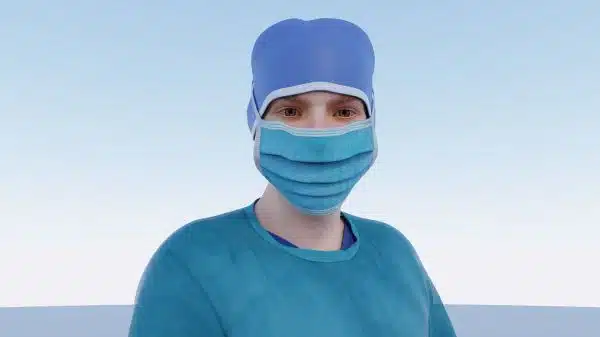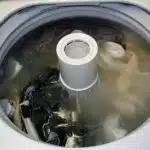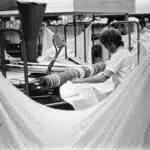The importance of cleanliness in the medical industry cannot be overstated. Medical scrubs are an essential component of the uniform worn by healthcare professionals, and it is imperative that they are washed and cared for properly to maintain a hygienic environment. As a clinical laundry technician, I have observed that many individuals do not understand the proper methods of washing and caring for their medical scrubs, which can lead to contamination and potential health hazards.
To ensure that medical scrubs are cleaned effectively, it is crucial to follow specific guidelines. This article aims to provide detailed instructions on how to wash and care for medical scrubs, including advice on selecting appropriate detergents, water temperature, drying methods, and ironing. By following these guidelines, healthcare professionals can ensure that their scrubs remain clean and hygienic, reducing the risk of infection transmission in the workplace.
The Importance Of Cleanliness In The Medical Industry
Cleanliness is crucial in the medical industry. It is essential to maintain hygiene standards to prevent the spread of infections and diseases. The importance of cleanliness cannot be overstated as it is part of the duty of healthcare professionals to provide a safe environment for their patients.
The medical sector requires strict adherence to hygiene standards, which include wearing clean clothing, especially when handling patients. Medical scrubs play a significant role in ensuring cleanliness in hospitals, clinics, and other healthcare facilities. Scrubs are designed to keep healthcare workers comfortable and safe while performing their duties.
Understanding the importance of cleanliness in the medical industry can lead to effective infection control practices. Therefore, it is vital for healthcare professionals to take extra care when washing and caring for their medical scrubs. In the following section, we will discuss various types of medical scrubs that are commonly used in healthcare facilities.
Understanding The Types Of Medical Scrubs
- Medical scrubs come in a variety of styles and materials, from polyester/cotton blends to polyester/rayon blends.
- Different types of medical scrubs may require different methods of care, depending on the fabric materials used.
- It is important for clinical laundry technicians to understand the types of medical scrubs available, as well as the fabric materials used in their construction, in order to properly wash and care for them.
- Furthermore, it is important to take into account the manufacturer’s instructions for washing and caring for the medical scrubs, as they may vary depending on the type of fabric and construction used.
Types Of Medical Scrubs
Understanding the types of medical scrubs is essential in selecting the right uniform for healthcare professionals. Different types of medical scrubs are available in the market, each with their unique features and benefits. Popular brands such as Cherokee, Dickies, and Grey’s Anatomy offer a wide range of options to choose from. Cost-effective options are also available, including generic brand scrubs that provide comfort and durability at affordable prices.
Medical scrubs come in various styles, ranging from traditional v-neck tops to modern mock wrap tops. The fabric used for medical scrubs is another important consideration. Cotton and polyester blends are popular choices as they provide comfort and breathability while being durable enough to withstand multiple washes. Some brands even offer moisture-wicking technology that helps keep healthcare professionals dry during long shifts.
In summary, understanding the types of medical scrubs available is crucial for healthcare professionals looking for optimal comfort and functionality in their workwear. Popular brands such as Cherokee and Grey’s Anatomy offer a variety of styles and fabrics to choose from while cost-effective options like generic brand scrubs can still provide quality at an affordable price point. Healthcare professionals should consider their individual needs when selecting a scrub type that meets their requirements for comfort, durability, and style.
Fabric Materials
Medical scrubs are an essential uniform for healthcare professionals. The right type of medical scrub can provide optimal comfort and functionality for the wearer, allowing them to carry out their duties with ease. One crucial consideration when selecting medical scrubs is the fabric material used. The choice of fabric material can impact the durability, longevity, and eco-friendliness of the scrub.
Cotton and polyester blends are among the most popular fabric materials used for medical scrubs. These fabrics offer a balance of comfort, breathability, and durability that make them suitable for long shifts in healthcare settings. Additionally, some brands even offer moisture-wicking technology that helps keep healthcare professionals dry during extended work hours.
For those seeking eco-friendly options, there are now medical scrubs made from sustainable materials such as bamboo or recycled polyester. These environmentally conscious options not only reduce waste but also offer similar levels of comfort and durability as traditional cotton and polyester blends. By understanding the different fabric material options available for medical scrubs, healthcare professionals can select a scrub that meets their specific needs while contributing to a more sustainable future.
Selecting The Right Detergent For Medical Scrubs
When it comes to washing medical scrubs, selecting the right detergent is crucial. As a clinical laundry technician, you need to keep in mind that these scrubs are often contaminated with potentially harmful substances such as blood and bodily fluids. Choosing an eco friendly detergent that is gentle on the fabric but tough on stains is important. Eco-friendly detergents are not only better for the environment, but they also reduce the risk of allergic reactions or skin irritation among healthcare workers.
Another thing to consider when selecting a detergent is how often to replace old ones. Over time, detergents can lose their effectiveness and may even become a breeding ground for bacteria if left unused for extended periods. It’s recommended that you replace your detergent every six months or so to ensure maximum cleaning power and prevent any potential health hazards from contaminated detergents.
In summary, choosing the right detergent for washing medical scrubs requires careful consideration of both its efficacy and environmental impact. Opting for eco friendly options not only benefits our planet but also protects healthcare workers from potential allergic reactions or skin irritations. Additionally, regularly replacing old detergents ensures maximum cleaning power and prevents any potential health hazards from contaminated products. In the next section, we will explore another important aspect of washing medical scrubs: the ideal water temperature for optimal cleaning results.
The Ideal Water Temperature For Washing Medical Scrubs
The ideal water temperature for washing medical scrubs is a crucial aspect of their care and maintenance. It is essential to use the right temperature to ensure that the scrubs are cleaned effectively without damaging the fabric. The ideal water temperature for washing medical scrubs varies depending on the fabric type.
For cotton or polyester blend scrubs, it is best to use warm water between 60°C and 80°C. This temperature range ensures that all bacteria and stains are removed while preserving the integrity of the fabric. However, for delicate fabrics such as those made from silk or linen, it is recommended to use cold water at around 30°C. Hot water can cause shrinkage and damage to such fabrics.
In summary, using the ideal water temperature when washing medical scrubs is crucial in maintaining their quality and prolonging their lifespan. It is important to consider the material composition of each scrub before selecting the appropriate water temperature for cleaning them. By following these guidelines, you can ensure that your medical scrubs remain clean and hygienic while retaining their durability and appearance. In the next section, we will discuss how sorting medical scrubs by color and fabric type can further optimize their care and maintenance process.
Sorting Medical Scrubs By Color And Fabric
- Medical scrubs are typically identified by color-coding in order to distinguish between different medical personnel.
- The fabric type of medical scrubs is also important to consider when washing and caring for them as different fabrics may require different cleaning methods.
- It is important to note that the wash temperature for medical scrubs should be determined by the fabric type of the garment.
- Cotton-based medical scrubs should be washed in warm or cold water, while polyester and poly-cotton scrubs should be washed in cold water.
- When using bleach to clean medical scrubs, it is recommended to use a non-chlorine variety, as chlorine bleach can cause discoloration and fading.
- In order to properly care for medical scrubs, it is important to follow the manufacturers’ instructions, which are usually found on the garment’s label.
Color-Coding
When it comes to sorting medical scrubs, color-coding is an essential part of the process. It involves separating different colored scrubs from each other and washing them separately to maintain their colors. This prevents the colors from bleeding or fading during the washing process. The color selection for medical scrubs varies depending on the hospital or healthcare facility. Some facilities have specific colors for different departments, while others allow staff to choose their own colors.
The washing methods used for each color-coded group of medical scrubs also vary. For example, white scrubs are often washed in hot water with bleach to remove stains and bacteria. On the other hand, darker colored scrubs are typically washed in cold water with a mild detergent to preserve their colors and prevent fading. It is important to follow these washing methods to ensure that the scrubs last longer and remain looking professional.
Effective color-coding and proper washing methods are crucial for maintaining the quality of medical scrubs. As a clinical laundry technician, it is our job to ensure that every scrub is sorted correctly and washed according to its corresponding method. By doing so, we contribute to maintaining a clean and professional environment for healthcare workers who serve others tirelessly every day of their lives.
Fabric Type
As a clinical laundry technician, it is essential to understand the different types of medical scrubs and their corresponding fabric types. Medical scrubs come in various fabrics such as cotton, polyester, spandex, and blends of these materials. Cotton is the most commonly used fabric for medical scrubs because of its softness and breathability. Scrubs made from polyester are durable and resistant to wrinkling and shrinking. Spandex provides stretch and flexibility to scrubs, making them more comfortable for healthcare workers who need to move around frequently.
Choosing the best fabric for medical scrubs depends on several factors such as comfort, durability, and functionality. For instance, cotton is suitable for healthcare workers who work in warm environments because it allows air circulation. On the other hand, polyester-based scrubs are ideal for those who work in colder settings because they provide warmth. Scrubs made from spandex or blends of fabrics are perfect for healthcare workers who need a combination of flexibility and durability.
Sorting medical scrubs by fabric type is crucial to maintain their quality over time. Different fabrics require different washing methods to ensure that they remain clean and functional. As a clinical laundry technician, it is our responsibility to sort medical scrubs according to their fabric type and wash them accordingly. This helps extend the life span of the scrubs while maintaining their appearance and functionality.
In conclusion, understanding the different types of medical scrub fabrics is essential when sorting them for washing purposes. Choosing the right fabric ensures that healthcare workers are comfortable while performing their duties while also extending the lifespan of the scrubs themselves. By properly sorting medical scrubs by fabric type before washing them thoroughly in accordance with industry standards we can make certain that they remain clean, functional, and professional-looking throughout their working lives in a hospital or other health care facility environment – ready for use when needed most by those serving others at all times every day!
Wash Temperature
As a clinical laundry technician, sorting medical scrubs by color and fabric is crucial to maintain their quality and professional appearance. In addition to fabric type, wash temperature is another important factor that needs careful consideration during the laundry process. The optimal wash temperature for medical scrubs depends on several factors such as the fabric type and level of soiling.
The hot vs cold debate when it comes to washing medical scrubs is a common topic in the industry. Hot water can effectively remove heavy soil and stains, kill bacteria, and sanitize fabrics. However, not all fabrics can withstand high temperatures without shrinking or fading. On the other hand, cold water is gentler on fabrics but may not be effective in removing stubborn stains or sanitizing them completely. Therefore, it is important to follow manufacturer recommendations for each type of scrub when determining the optimal wash temperature.
As a clinical laundry technician, it is our responsibility to ensure that medical scrubs are washed at the appropriate temperature based on their fabric type and level of soiling. By doing this, we can extend the lifespan of the scrubs while also maintaining their appearance and functionality over time. Proper sorting by color and fabric along with washing at optimal temperatures will help ensure that healthcare workers have clean, comfortable scrubs ready for use whenever they are needed most.
Pre-Treating Stains On Medical Scrubs
After sorting out your medical scrubs by color and fabric, it’s essential to pre-treat any stains before washing them. Stains can be challenging to remove if not treated properly, so it’s crucial to have the right tools on hand. One effective method for pre-treating stains is using vinegar. Its acidic properties help break down stubborn stains like blood, sweat, and urine. Dilute one part vinegar with three parts water and apply the solution directly onto the stain. Let it sit for 10-15 minutes before washing.
For tougher stains like grease or oil-based products, enzymatic cleaners are recommended. These cleaners contain enzymes that break down protein-based stains like blood or bodily fluids. Enzymatic cleaners are gentle on fabrics and safe for all colors but need time to work correctly, so let the cleaner sit on the stain for a minimum of 30 minutes before washing.
After pre-treating your medical scrubs for any stains, it’s time to select the right cycle when washing them. Medical scrubs should be washed in warm water at 60°C (140°F) to ensure that they are adequately sterilized and free from bacteria and viruses that may be present on them. You can use regular detergent as long as it does not contain bleach or fabric softener as these substances can damage the fabric’s integrity over time. A gentle cycle is recommended as this will prevent rubbing against other clothes in the wash that could cause piling or wear and tear on your scrub’s material.
Transitioning into our next section, choosing the right cycle when washing medical scrubs is crucial in extending their longevity and maintaining their quality even after multiple washes.
Choosing The Right Cycle For Washing Medical Scrubs
When it comes to washing medical scrubs, choosing the right cycle is crucial to ensure that they remain clean and intact. The first step in selecting the right wash cycle is to read the care label on the scrub. This label will provide information about the fabric type and any specific washing instructions that need to be followed.
Once you have gathered this information, the next step is to choose a detergent that is appropriate for medical scrubs. It is recommended to use a mild or gentle detergent as these options are less likely to cause damage or fading to the scrub’s colors. In addition, it is best to avoid using fabric softeners as they can leave residue on the scrubs and reduce their effectiveness in repelling fluids.
Finally, water temperature selection plays a key role in determining which cycle would be suitable for washing medical scrubs. Generally, hot water cycles are more effective in removing stains and killing bacteria; however, some fabrics may not tolerate high temperatures. Therefore, it is important to check the care label before selecting a water temperature setting. Choosing an appropriate cycle will not only maintain your scrub’s quality but also extend its lifespan.
To properly care for your medical scrubs after washing them, it is essential to dry them correctly.
Drying Medical Scrubs Properly
After choosing the right cycle for washing medical scrubs, it is important to dry them properly. One option is air drying, which is particularly helpful in preventing shrinking and fading of the fabric. Air drying also helps to reduce wrinkles on the scrubs, making them easier to iron if needed. It is best to hang them up using hangers or a clothesline after shaking out any excess water.
Another option is using a dryer, but caution should be exercised as high temperatures can damage the fabric and cause shrinkage. If a dryer must be used, choose a low heat setting and remove the scrubs from the dryer promptly once they are dry. Avoid overloading the dryer to ensure proper airflow and minimize wrinkling.
When caring for medical scrubs, using fabric softener can help keep them feeling soft and comfortable against your skin. However, it is important to use only a small amount as too much can lead to buildup on the fabric fibers. Alternatively, vinegar can be used as a natural fabric softener that won’t leave residue on your clothing.
- To prevent wrinkles while air drying your scrubs, shake them out before hanging them up.
- When using a dryer, choose low heat settings and avoid overloading it.
- Use caution when adding fabric softener and consider natural alternatives like vinegar.
Next section: Ironing Medical Scrubs for a Professional Look 4. Before ironing, make sure your scrubs are clean and dry.
Ironing Medical Scrubs For A Professional Look
Ironing techniques play a vital role in ensuring that medical scrubs remain wrinkle-free and presentable. Before ironing, it is crucial to check the care label for instructions on the recommended iron setting. Using too much heat can damage the fabric, while using too little heat may not remove wrinkles effectively. If the fabric is delicate, it is advisable to use a pressing cloth to prevent scorch marks.
Wrinkle prevention starts by removing the scrubs from the dryer as soon as they are dry. Leaving them in the dryer for an extended period results in hard-to-remove wrinkles. After removing them from the dryer, hang them immediately on a hanger or fold them neatly to avoid wrinkles. If possible, iron your scrubs while they are still slightly damp for easier wrinkle removal.
To iron medical scrubs correctly, start with the sleeves and then move onto the body of the garment. When ironing sleeves, start at the shoulder seam and work towards the cuff in sections. For pants, begin with one leg and then move onto another. It is essential to avoid stretching or pulling when ironing your scrubs since this can cause distortion or puckering of seams.
Moving forward into storing medical scrubs in a clean environment, it is important to ensure that you have enough space in your storage area to keep them separate from other clothes. Hanging up your scrub tops and pants will not only help prevent wrinkles but also keep them organized and easily accessible when needed.
Storing Medical Scrubs In A Clean Environment
How to Store Medical Scrubs in a Clean Environment
Have you ever stored your scrubs in a cluttered and dirty environment? This can lead to germ buildup, unpleasant odors and even stains. As a clinical laundry technician, it’s important to know how to store your medical scrubs properly. Here are three tips for organizing your scrubs and keeping them fresh:
Use designated storage space: Assign a specific area in your home or workplace for storing your scrubs only. Avoid placing them near contaminated items like shoes or dirty laundry. This will prevent cross-contamination of germs and odors.
Keep them clean: Before storing, make sure your medical scrubs are clean and dry. Don’t pile them up when they’re damp as this can lead to mold growth and unpleasant smells.
Protect from dust: Use garment bags or plastic covers to protect your scrubs from dust build-up. Make sure they’re breathable to prevent moisture build-up.
By following these simple tips, you’ll be able to keep your medical scrubs organized and fresh for use every time you need them.
Transition: Now that we’ve learned how to store our medical scrubs in a clean environment, let’s move on to the next section where we’ll discuss tips for handling contaminated medical scrubs.
Tips For Handling Contaminated Medical Scrubs
It is crucial for healthcare workers to know how to handle contaminated medical scrubs properly. One of the most common types of stains on scrubs are blood stains, which can be particularly difficult to remove. To manage this type of stain, it is important to act quickly and pre-treat the area before washing.
When dealing with bodily fluids on scrubs, it is essential to wear protective gloves and dispose of any contaminated materials in a proper manner. Bodily fluids such as urine, vomit or feces can contain infectious agents that pose a risk not only to healthcare workers but also to patients and visitors. Scrubs should be removed immediately after exposure to any bodily fluids and washed separately from other laundry.
In addition to following proper protocols when handling contaminated scrubs, healthcare facilities can benefit from using a professional laundry service. Professional laundry services use specialized detergents and equipment that are specifically designed for medical textiles. They are also able to thoroughly sanitize and disinfect scrubs, reducing the risk of cross-contamination between patients. By outsourcing their laundry needs, healthcare facilities can save time and resources while ensuring that their staff has access to clean and hygienic scrubs at all times.
The Benefits Of Using A Professional Laundry Service
Like a skilled surgeon with a scalpel, a professional laundry service can expertly clean and care for medical scrubs. The benefits of using such a service are numerous and far-reaching. Firstly, it saves time and energy that could be better spent caring for patients. Secondly, the cost-effectiveness of utilizing a laundry service is undeniable.
When considering the benefits of using a professional laundry service, one cannot ignore the cost savings associated with outsourcing this task. The cost of purchasing and maintaining high-quality washing machines, dryers, and detergents can quickly add up. Additionally, the time saved by delegating this responsibility to an outside party allows medical professionals to focus on providing top-notch patient care.
Furthermore, professional laundry services employ trained technicians who are experts in cleaning and caring for medical garments. These individuals utilize specialized equipment and detergents to ensure that scrubs are properly disinfected and maintained. By utilizing these services, medical professionals can rest assured that their scrubs will be impeccably cleaned and cared for.
As important as it is to have clean scrubs, it is equally essential to have a clean washing machine. In order to maintain optimal cleanliness standards, it is crucial to regularly disinfect your washing machine. In the next section, we will discuss the proper methods for cleaning and disinfecting your washing machine to ensure that your medical scrubs remain fully sanitized.
Cleaning And Disinfecting Your Washing Machine
Maintaining the cleanliness of your washing machine is essential for cleaning and disinfecting medical scrubs. A clean washing machine not only ensures cleaning efficiency but also prolongs its lifespan. Regular maintenance should be performed to avoid malfunction and keep the machine running smoothly.
To properly clean and disinfect your washing machine, follow these three steps:
- Start with an empty machine and add a cup of white vinegar to the detergent dispenser.
- Run a hot cycle with the highest water level setting.
- Once the cycle is complete, wipe down the inside of the drum with a damp cloth to remove any remaining residue.
Machine maintenance is crucial in preventing malfunctions that may affect its performance in cleaning medical scrubs. Neglecting regular cleaning can cause buildup inside the machine, which can lead to clogs or even damage to internal components.
Properly maintaining your washing machine can ensure that it runs efficiently and effectively in cleaning your medical scrubs. By following these simple steps, you can keep your washing machine in good condition and prevent costly repairs down the line. In the next section, we will discuss common mistakes to avoid when washing medical scrubs.
Common Mistakes To Avoid When Washing Medical Scrubs
- Hot water should not be used to wash medical scrubs, as the heat can cause fading or shrinkage in the fabric.
- In order to avoid discoloration, medical scrubs should be washed separately from other garments, and colors should be sorted before washing.
- Overloading the washer can cause medical scrubs to become tangled and wrinkled, leading to poor cleaning performance and potentially damaging the fabric.
- It is important to follow the garment’s specific care instructions and always use a mild detergent suitable for the fabric.
- Medical scrubs should be dried on a low heat setting and promptly removed from the dryer to avoid wrinkling.
- It is essential to inspect medical scrubs for stains and treat them before washing to ensure the best possible cleaning results.
Using Hot Water
When it comes to washing medical scrubs, a common mistake that many people make is using hot water. While hot water can be effective in removing stains and killing bacteria, it can also lead to shrinkage of the fabric. As a clinical laundry technician, it is important to educate healthcare workers on the proper washing techniques to prevent this from happening.
Using hot water can cause the fibers in the fabric to contract, resulting in smaller and tighter-fitting scrubs. This not only reduces their comfort but also affects their functionality. Shrunken scrubs may not provide adequate protection against bodily fluids and other contaminants, which puts healthcare workers at risk of infection. Therefore, using lukewarm water or following the care label instructions for temperature settings is crucial for maintaining the integrity of medical scrubs.
In addition to preventing shrinkage, using hot water can also damage the color and texture of medical scrubs over time. As a result, they may appear faded or worn out much sooner than expected. To ensure that healthcare workers look professional and presentable at all times, it is important to use appropriate detergents and avoid high temperatures when washing medical scrubs. By doing so, we can extend the lifespan of these garments while maintaining their effectiveness and safety features.
Not Separating Colors
Color separation is another important aspect of washing medical scrubs that should not be overlooked. Mixing different colors in one load can lead to color bleeding, resulting in discoloration and staining of the garments. As a clinical laundry technician, it is crucial to educate healthcare workers on the importance of separating colors when washing their scrubs.
To maintain the integrity of the fabric, it is recommended to separate whites, light colors, and dark colors into separate loads. This helps prevent color transfer and ensures that each garment receives proper care and maintenance. It is also important to follow care label instructions for each individual garment as some fabrics may require special treatment.
Neglecting to separate colors when washing medical scrubs not only affects their appearance but also their functionality. Discolored or stained scrubs may not be suitable for use in certain areas of the hospital where cleanliness is paramount. Additionally, color bleeding can weaken the fibers in the fabric, leading to premature wear and tear. By emphasizing color separation during the washing process, we can extend the lifespan of medical scrubs while maintaining their safety features and professional appearance.
Overloading The Washer
As a clinical laundry technician, it is crucial to avoid common mistakes when washing medical scrubs. One of these mistakes is overloading the washer. Overloading occurs when too many garments are placed in the washer, compromising the quality and cleanliness of the load.
Overloading the washer can lead to several issues, including preventing shrinkage and affecting the efficacy of washing with bleach. When there are too many scrubs in one load, there isn’t enough space for water and detergent to circulate properly, leading to insufficient cleaning. Moreover, overcrowding can cause friction between garments, resulting in pilling or tearing.
To prevent overloading, it is recommended to limit the number of scrubs added per load and follow manufacturer recommendations for machine capacity. It is also important to check care labels for specific washing instructions as some fabrics require more space or less agitation than others. By avoiding overloading and ensuring that each garment receives proper care during washing, we can maintain the integrity of medical scrubs and extend their lifespan.
Frequently Asked Questions About Washing And Caring For Medical Scrubs
Despite the importance of maintaining a clean and hygienic environment in healthcare facilities, the task of washing medical scrubs can be daunting. Many healthcare professionals are concerned about damage to their uniforms or failure to remove stubborn stains. It is understandable that some may feel frustrated when trying to maintain their scrubs’ appearance and cleanliness.
To ensure that medical scrubs remain in pristine condition, it is important to follow proper laundering procedures. Stain removal, for instance, should be addressed as soon as possible. Blood, urine, and other bodily fluids can leave permanent marks if not treated promptly. Pre-treating with a stain remover before washing can help prevent this. In addition, avoiding the use of fabric softeners and opting for unscented detergent can prolong the lifespan of medical scrubs.
It is essential for healthcare professionals to prioritize the care and maintenance of their uniforms. Not only does it reflect professionalism and attention to detail, but it also contributes to infection control measures. By following best practices such as stain removal and avoiding fabric softeners, medical scrubs can withstand frequent washing and continue to look presentable for years to come.
Conclusion
Cleanliness is of utmost importance in the medical industry, which is why the proper care and maintenance of medical scrubs cannot be overlooked. Understanding the types of medical scrubs, selecting the right detergent, and washing at the ideal water temperature are all crucial steps in keeping scrubs clean and free from harmful bacteria. It is also important to sort scrubs by color and fabric to prevent any unwanted dyes or damage.
While some may choose to wash their scrubs at home, utilizing a professional laundry service can provide added benefits such as deep cleaning and disinfecting. It’s also essential to regularly clean and disinfect your washing machine to ensure it remains in good condition and doesn’t inadvertently spread bacteria onto your clothing.
In conclusion, properly washing and caring for medical scrubs is a vital part of maintaining cleanliness in healthcare settings. By following these guidelines, we can ensure that our scrubs remain free from contaminants and help promote a safe and healthy environment for both patients and healthcare workers alike. Remember, attention to detail when it comes to laundry can make all the difference in maintaining a sterile environment.
Image Credits
- “Gen3-Medical-Scrubs-004c_face-and-mask_concerned” by Paul Schultz (featured)





























